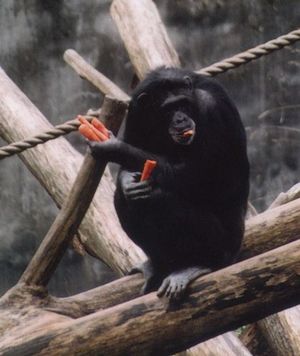Food

Chimpanzees spend about
6-8 hours a day foraging for food. Their diet includes a
variety of foods such as fruits, seeds, berries, leaves,
pith, barks, resins, and plants. Fruit and vegetable
species make up the bulk of the chimpanzee diet while
insects, bird eggs and meat from small and medium sized
mammals provide additional sources of food. Among the
mammal species which are hunted, killed and eaten are
lizards, bushbuck and bushpigs, colobus monkeys and
baboons.
Hunting and meat eating
have been observed among most populations of chimpanzees.
Hunting for monkeys, for example, usually requires the
cooperation of one or more chimpanzees. The prey may be
spotted moving in the tall trees then chased until
captured. The hunter kills his prey with a bite to the
head or neck.
Meat is usually shared.
The successful chimpanzee hunter usually gives portions of
the kill to those chimpanzees requesting to share. Hands
and feet are used to hold the carcass securely while sharp
canines are used to tear off chunks of meat. A wadge or
ball of masticated leaves is chewed with small portions of
meat perhaps to add flavor or to prolong the enjoyment of
a favored food. The wadge of leaves is usually not
swallowed. In most instances, males are more successful
hunters than females.
Chimpanzees may go to
specific trees and appear to be eating leaves. In fact the
leaves are not chewed and digested because they are not
eaten as part of the normal diet. Some leaves are believed
to be used for medication. For example Dr. Eloy Rodriguez
of Cornell University believes that the Aspilia plant is
used by chimpanzees to treat fungal infections (see Eloy
Rodriguez, Zoopharmacognosy).
Captive Chimpanzees

In zoo habitats,
chimpanzees do not need to travel long distances looking
for food. Their food is provided for them. However, modern
zoos no longer feed chimpanzees once a day, instead they
are given smaller amounts of food several times a day.
Seeds, raisins and other preferred treats are thrown in
the browse covering the habitat floor or in the grass in
the outside enclosure. Hunting for treats in the browse
occupies the chimpanzees for hours.


